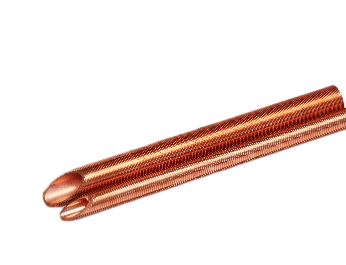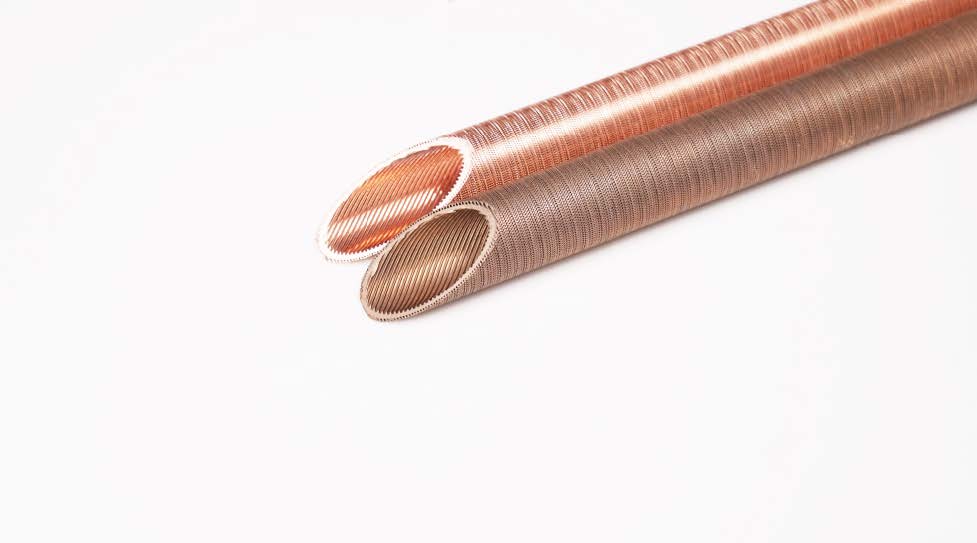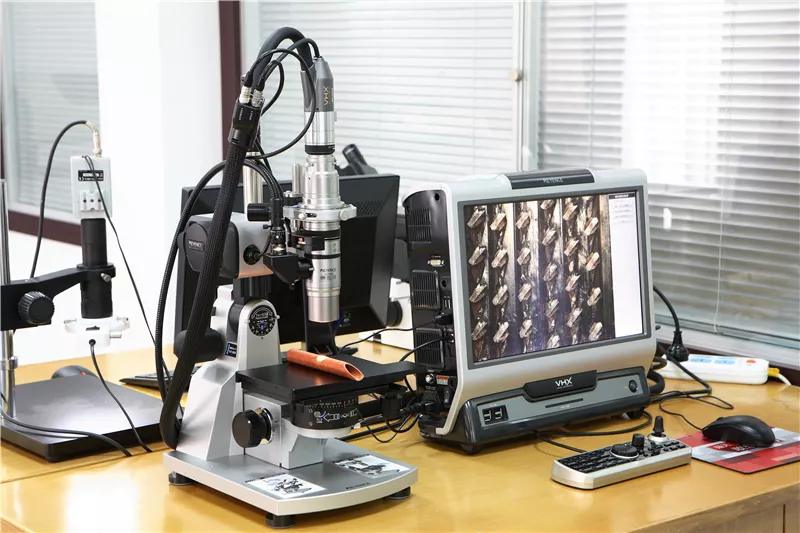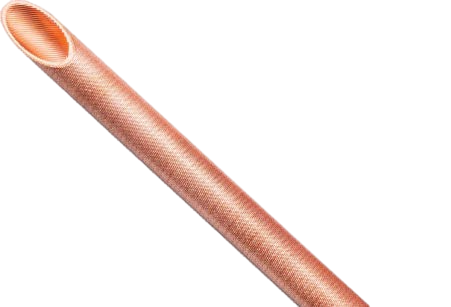Low Finned Tube
A type of extruded tubing with small low fins
Professional Low Finned Tube Manufacturer
Cufin Tube specializes in manufacturing a wide range of low fin tube, which also known as integral finned tubes, are finned tubes where the fins are formed directly from the base tube material. This is typically achieved through cold rolling fins onto the base tube. Unlike other finned tubes, their application isn’t limited to gas-liquid heat exchangers, and they are increasingly used in various fluid heat exchangers, including shell and tube heat exchangers.

Technical Specification:
- Tube Outside Diameter: Ranges from 12.7 to 31.75 mm. Common sizes include 12.7mm, 15.88mm, 19.05mm, and 25.4mm.
- Tube Wall Thickness: Typically ranges from 1.65 to 3.0 mm.
- Tube Length: Can reach a maximum of 18500 mm.
- Fin Thickness: Generally ranges from 0.3 to 0.5 mm.
- Fin Height: Typically between 0.9 to 1.3 mm, but can also range from 0.5 mm to 1.5 mm
Low Fin Tube Parameter
| Code | Plain End | Plain End | Plain End | Finned Section | Finned Section | Finned Section | Finned Section | Nominal (m2/m) | Surface Area Ratio |
|---|---|---|---|---|---|---|---|---|---|
| CTHF | Outside Diameter(mm) | Inside Diameter(mm) | Nominal Wall(mm) | Outside Diameter(mm) | Fin Height (mm) | Min Wall Under Fins(mm) | Fin Per Inch(mm) | Ourside Surface Area | Outside to Inside |
| 39-19-7 | 19 | 16 | 1.5 | 39 | 9 | 1.6 | 7 | 0.535 | 10.64 |
| 45-23-7 | 23 | 19.8 | 1.6 | 45 | 10.5 | 1.7 | 7 | 0.704 | 11.32 |
| 46-25.9-5 | 25.9 | 22.4 | 1.75 | 46 | 9.5 | 1.85 | 5 | 0.535 | 7.6 |
| 47-25.9-7 | 25.9 | 22.4 | 1.75 | 47 | 10.5 | 1.85 | 7 | 0.75 | 10.65 |
| 48-25.4-7 | 25.4 | 22 | 1.7 | 48 | 10.5 | 1.8 | 7 | 0.76 | 11.13 |
What Is Low Fin Tube ?
Low fin tube, also known as integral fin tube, is a type of heat exchanger component where the fins are formed directly from the base tube material itself. This design significantly enhances the surface area available for heat transfer, improving efficiency in various applications. Main features:
- Strong Bond: The fins are inherently bonded to the tube, eliminating any potential for gaps or weaknesses at the interface.
- High Thermal Conductivity: When the fin and tube are made from the same material, there’s excellent thermal conductivity between them, minimizing thermal resistance.
- Improved Durability: The integral construction can lead to increased strength and resistance to vibration and fatigue.
- Versatility: Can be manufactured with various fin shapes and sizes to suit different applications.


Advantages Of Cufin Tube's Low Fin Tube
- Enhanced Heat Transfer: The increased surface area from the fins improves heat transfer efficiency. The heat transfer ratio can reach 2.67 to 3.46 times that of a smooth tube of equal diameter.
- Durability: They have a strong resistance to fly ash scour and high environmental durability.
- Compact design: They are compact and improve the thermal performance of a heat exchanger without changing the shell size or piping.
- Simple Installation: Installation is economical, reduces connection points, and minimizes the chance of leakage.
How do Low Fin Tube Work?
Low fin tubes enhance heat transfer through the principle of extended surface area. Here’s how they work:
- Increased Surface Area: Fins are added to the external surface of the tubes. The fins significantly expand the surface area in contact with the surrounding fluid or gas. This increased surface area is the key to enhanced heat transfer.
- Heat Transfer Process: One fluid flows through the tubes, while the other fluid flows over the fins and tubes. Heat is transferred between the fluid inside the tube and the fins. The fins facilitate heat exchange by increasing the surface area exposed to the fluid or gas.
- Heat Dissipation/Absorption: In applications like radiators, the fluid inside the tube absorbs heat from its surroundings. The fins help in spreading this heat over a larger area, allowing more efficient cooling by the surrounding air. In condensers and evaporators, the fluid inside the tube releases heat to the fins, which then dissipates it to the surrounding air or another fluid.
- Conduction, Convection, and Radiation: Heat transfer involves conduction through the tube walls, convection between the fluid and finned surface, and radiation between surfaces at different temperatures. The increased surface area promotes convective heat transfer.

Applications Of Low Fin Tube
Low fin tubes are widely used in industries such as:
- Heat Exchangers: Low fin tubes are widely used in heat exchangers across various industries. Their increased surface area enhances heat transfer rates, making heat exchangers more effective and compact1.
- HVAC Systems: They are incorporated into HVAC units to efficiently heat or cool air, ensuring comfortable indoor environments.
- Refrigeration: Finned tubes are used to remove heat from the refrigerant and facilitate its condensation, enabling efficient cooling and maintaining optimal temperatures in refrigeration systems.
- Power Generation: In power plants, low fin tubes play a crucial role in condensers and boilers. They are used in condenser tubes to transfer heat from steam to cooling water and in boiler tubes to transfer heat from combustion gases to water/steam, improving power generation processes overall.
- Oil and Gas Industry: The oil and gas industry utilizes low fin tubes in the heating and cooling of fluids during refining and processing operations. They enable efficient heat transfer in heat exchangers, condensers, and air coolers used in various stages of production and play a vital role in maintaining the optimal temperature of fluids
These tubes play a crucial role in air-cooled heat exchangers, where efficient heat transfer is essential for system performance.
Other Applications Including :
- Air Preheaters
- Food Industry
- Drying Processes
- Steel Industry
- Steam Coils
- Timber Drying
- Chemical Industry
- General Engineering
- Waste Heat Recovery
- Industrial Ovens
Book A Video Call
Your reliable China partner of finned tubes for heat exchangers
Mass Production Photos
Check how we will produce your finned tube bulk orders in our future cooperation. We take every step seriously, from raw material to packaging, to ensure that the fin tubs delivered to your warehouse are 100% qualified.
Frequently Asked Questions
About Low Fin Tubes For Heat Exchangers
What are the materials for low fin tubes?
Common materials include copper, aluminum, stainless steel, etc. The selection of materials depends on factors such as temperature, pressure, and corrosiveness of the application environment.
What are the shapes of low fin tubes?
What are the application areas of low fin tubes?
The low fin tube is widely used in:
Heat exchangers: air preheater, evaporator, condenser, etc
Chemical industry: reactors, heaters
Refrigeration industry: condensers, evaporators
Automotive industry: radiators, oil coolers
How to choose integral finned tubes?
When selecting low fin tubes, the following factors need to be considered:Operating conditions: temperature, pressure, flow rate, medium, etc.
Heat transfer requirements: the required amount of heat transfer.
Size limitation: Installation space.
Material requirements: corrosiveness of the medium, temperature, etc.
What is the cost of low fin tubes?
The cost of low fin tube is influenced by various factors, including material, size, shape, quantity, etc. Generally speaking, the cost of low fin tube is slightly higher than that of welded finned tubes, but their performance and lifespan advantages often offset the higher costs.
How is the maintenance of low fin tubes?
The maintenance of low fin tube is relatively simple, mainly focusing on keeping the pipeline clean and preventing dirt blockage. Regularly check for leaks or damage.
What are the advantages of integral finned tubes compared to other finned tubes?
The low fin tube has better thermal conductivity, mechanical strength, and corrosion resistance. Compared with welded finned tubes, integral finned tubes have fewer seams, are less prone to leakage, and have a longer lifespan.
What is the typical lead time for manufacturing and delivering low fin tubes?
The lead time for low fin tube is typically 4-5 weeks, depending on the order size and customization requirements. Expedited production can be arranged for urgent projects.
Request A Free Quote
We'd like to work with you
Send us a message if you have any question or request a quote. Our expert will response within 24 hours and help you custom your finned tubes heat exchanger solution!


